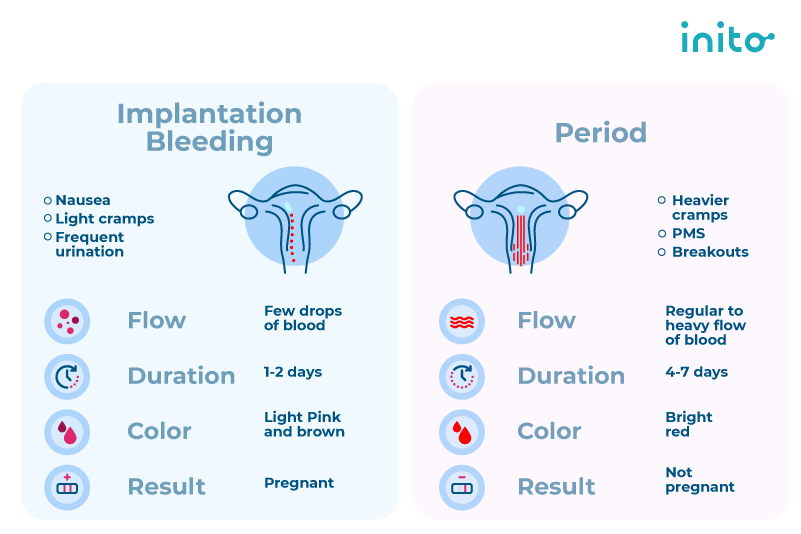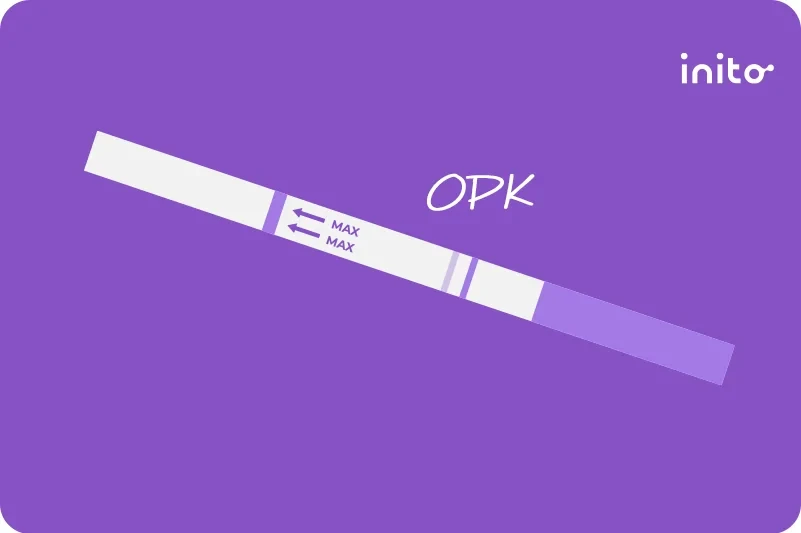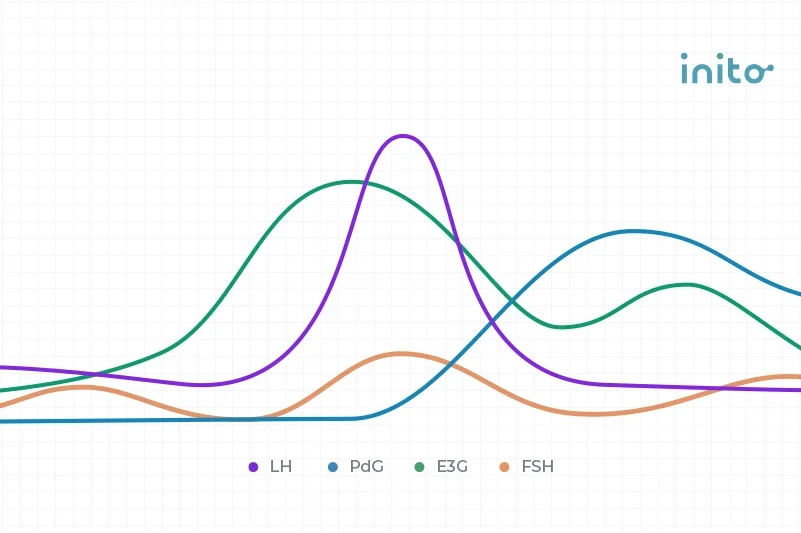Content table
If you have been waiting for the right time to take a pregnancy test, you will likely be eager to catch any early signs that your baby is on the way.
Well, the good news is that one of those signs is implantation bleeding — the blood that flows when a fertilized egg attaches to your womb.
Unfortunately, implantation bleeding and periods are quite similar. Dozens of questions will bombard you as you wonder if you are pregnant or is it just another bleeding day of your period!
Thankfully, this article will do justice to explaining the differences between implantation bleeding and periods, as well as how to be entirely sure when you are actually pregnant.
Key Takeaways
- Implantation bleeding is a faint vaginal bleeding that happens within 1 to 2 weeks after conception.
- Implantation bleeding lasts for 1 to 3 days while periods last 4 to 7 days.
- Implantation bleeding is a sure way of knowing if you are pregnant or not.
- Common symptoms include cramping, faint bleeding, headache, nausea, and breast sensitivity.
- Implantation bleeding looks much like periods but is usually pinkish-brown in color, while periods are light brown or pink to crimson red.
What Is Implantation Bleeding?
According to experts from ACOG, implantation bleeding is a faint bleeding from the vagina that some women experience 1 to 2 weeks after conception.
Although it may appear to be a light period, it is actually an early sign of pregnancy.
When a fertilized egg attaches to the uterine wall, it may cause a rupture in the surrounding blood vessels, leading to implantation bleeding.
The most annoying fact is that this blood flow is almost the same as normal spotting or menstrual flow. The only certain way to tell them apart is by taking a pregnancy test.
Contrarily, heavy bleeding can be a sign of a problem. Call your doctor immediately if you experience heavy flow or painful cramps.
When Does Implantation Bleeding Occur?
After the brief meet-and-greet between a sperm and your egg (fertilization), an embryo forms. It travels towards your uterus to attach itself to the uterine wall.
During this process of attachment, there may be bleeding. This may happen near the time you experience your period.
It is possible that you might mix it up with your period when in reality, you’re pregnant.
Generally, implantation bleeding is normal and it doesn’t signify any abnormalities in your developing baby.
Common Symptoms of Implantation Bleeding
If you are expecting a baby, implantation bleeding is considered one of the early pregnancy symptoms.
But due to the fact that implantation bleeding happens near the usual time you see your period, you are torn between a possible pregnancy or another monthly flow cycle.
Thanks to these common signs below, you have all the answers to the million questions racing through your mind. And they include:
- Light or faint cramps
- Mood swings
- Nausea or vomiting
- Increased breast sensitivity
- Lower back pain
- Headaches
Your hormonal changes, which are necessary to support pregnancy, are responsible for these early pregnancy symptoms.
However, let’s remember that you can also experience these symptoms just before your period.
Timeline of Periods vs Implantation Bleeding
If you’re hoping to get pregnant, then you’ll be familiar with the nerve-wracking two-week waiting time from ovulation to the next menstrual period.
Detecting the signs accurately may not be straightforward, but here’s the good news: Timing can help you point out what you’re experiencing.
First off, implantation bleeding and your period don’t happen simultaneously. While implantation bleeding happens a bit earlier, your period shows up much later.
Periods
Let’s walk through the schedule of your cycle so you can track this on your period calendar.
Day 1 is the beginning of your menstrual cycle, the day you start bleeding. Most women ovulate 12-14 days before their next period date.
The egg is alive for about 24 hours after it has been released, but sperm lives from 3 to 5 days in your body.
Although you can’t really tell when fertilization occurs, it is mainly within 24 hours of ovulation. The egg needs to meet the sperm in the fallopian tube to be fertilized and then reach the uterus to attach in time.
Implantation Bleeding
Implantation bleeding occurs around 6 to 12 days after ovulation (6-12 DPO). You won’t see your period until 14 days after ovulation.
So, if you’re bleeding earlier or lighter than normal, then it is likely that the chances of implantation bleeding are higher than your period.
How Long Do You Experience Implantation Bleeding?
According to ACOG, a period typically lasts anywhere between two and seven days. In comparison, implantation bleeding typically lasts for one to three days, corresponding to the time it takes for the egg to implant in the uterine lining.
That aside, let’s remember that everyone is different, so some people will experience implantation bleeding longer than others.
Difference Between Implantation Bleeding vs. Periods
Implantation bleeding is not as rare as experts have recorded occurrences in 15 to 25 percent of pregnant women.
As we know by now, it is certainly not easy to differentiate between an early period and implantation bleeding.
But here is a list of the differences in signs between implantation bleeding and periods.

- Type of flow: Implantation bleeding is usually a faint spotting. Your period may start off light, but the flow might become heavier.
- Color: Implantation bleeding is usually pinkish-brown while menstrual flow may begin light pink or brown and change to bright red.
- Clotting: There are no clots in implantation bleeding. This usually happens during your period. If you see any clots, which consist of blood and tissue, then it is surely your period.
- Duration of flow: Implantation bleeding typically lasts for 1 to 3 days while your period lasts between 4 and 7 days.
- Implantation Cramps: Unlike period cramps, which are more intense, cramping in implantation cramps is short and light. You just need to pay attention to what your body is telling you. Anything less painful than normal might point towards signs of early pregnancy.
- Consistency: Implantation bleeding fluctuates meaning that it is not consistent. On the other hand, period flows are progressive and constant for the number of days they last.
Other Pregnancy Symptoms
In cases of early pregnancy, you may experience:
- Sensitive breasts
- Headaches
- Lower back pain
- Mood swings
- Nausea/vomiting
- Fatigue
However, these symptoms are also felt like a part of your premenstrual syndrome (PMS) since these symptoms occur due to progesterone rise after ovulation and implantation.
Should I Take a Pregnancy Test If I'm Spotting?
If there is a chance that you are pregnant, you might need to take a pregnancy test, especially since it is tricky to tell implantation from menstrual spotting.
Pregnancy tests work by measuring the level of the human chorionic gonadotropin (hCG) hormone in your blood. Your placenta makes the hormone to take care of the developing embryo.
A urine home pregnancy test is 99 percent accurate, as long as the test is still valid and you take it after the first day of your missed period.
Additionally, high-sensitivity tests are your best bet for distinguishing between spotting and pregnancy. They usually give accurate results, so you can take them to confirm your status.
Scheduling a meeting with your doctor for a blood pregnancy test can help tell if you are pregnant especially if you missed your period.
Complications and When to See a Doctor
First of all, implantation bleeding is a no-brainer and will disappear in a few days. However, be sure to watch out for critical signs so that you can alert your doctor promptly.
Having a confirmed pregnancy with an increased flow from implantation bleeding can show that there is a problem. You should contact your doctor immediately for medical assistance.
Also, if you experience any unusual bleeding pattern such as bleeding longer than seven days, bleeding earlier than your expected period, missed periods, bleeding after sex, or different colors of bleeding, then you should reach out to your doctor immediately.
Was this article helpful?
- Bleeding during pregnancy. ACOG
- Implantation bleeding: Normal in early pregnancy? Mayo Clinic.
- Mikolajczyk, R.T. et al. (2010). Characteristics of prospectively measured vaginal bleeding among women trying to conceive. Paediatr Perinat Epidemiol.
- Menstruation in girls and adolescents: using the menstrual cycle as a vital sign. ACOG
- Ovulation, conception & getting pregnant. Cleveland Clinic.
- Pregnancy – identifying fertile days | MedlinePlus Medical Encyclopedia.
- Fertility awareness-based methods of family planning. ACOG.












